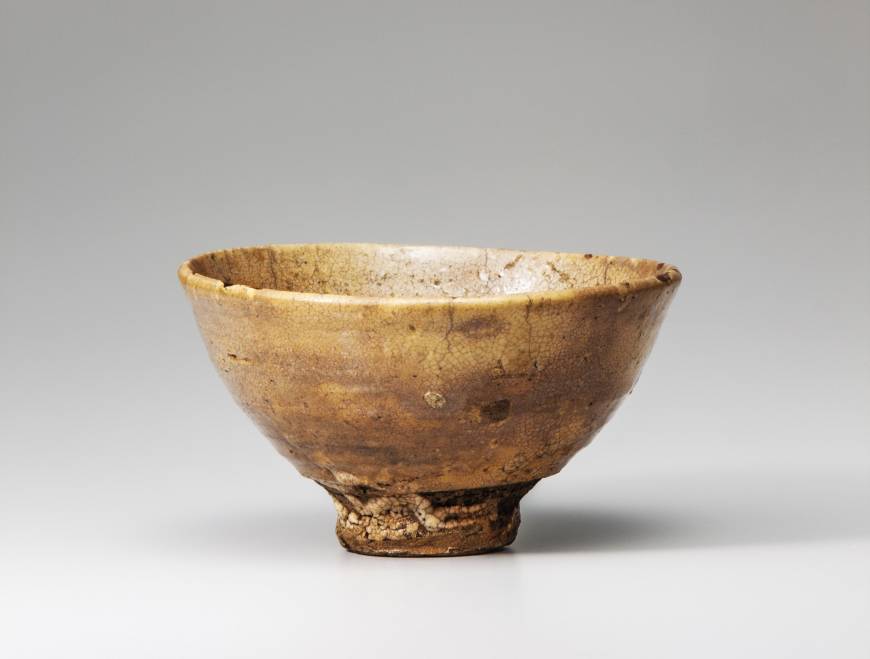Japan's national treasure: Korean ido pottery tea bowl KIZAEMON IDO
8th May 2015
Koraimono (means Korean ware)
Koraimono is a general term referring to tea utensils produced in the Korean Peninsula, in contrast with the Chinese-produced style of pottery known as "karamono." Around the mid-16th century, corresponding with the rise of the wabi-cha style of tea ceremony, this multi-purpose bowl produced in ordinary kilns throughout the Korean peninsula came to be known in Japan as "koraimono," and used as a tea bowl for matcha. In contrast with the celadon porcelain and black tenmoku glazing of Chinese karamono, koraimono tea bowls are characteristically plain, simplistic, and carefree products, and it is this simple beauty that captured people's hearts at the time. Alongside the rise of wabi-cha, koraimono tea bowls came to occupy a higher position than Japanese products, and they continue to be passed down between generations even to this day.
Because Korea was formerly known in Japan as Korai (Goryeo), tea bowls made in Korea were referred to as "Korai tea bowls." However, the period in which the majority of these products were made was not the Goryeo Period, but rather the Joseon Period.
Koraimono are divided into many categories, each with distinct names, including kyogen-bakama, unkaku, mishima, hakeme, muji hakeme, kohiki, ido, idowaki, totoya, soba, tamagode, kaki no heta, komogai, goki, warikodai, as well as others in Japanese.
Moreover, in the 17th century, items believed to be in demand from Japan, such as the goshomaru, irabo, hori-mishima, and kinkai tea bowls were produced; and indeed, the gohon tea bowl was produced in the kilns of the Japanese settlement in Pusan based on a demand from Japan.
tea bowl KIZAEMON IDO
Said to be the most prominent of tea utensils and of koraimono is the story of the Kizaemon Ido. Early on in the Tokugawa Period, around the Keicho era, a wealthy Osaka merchant by the name of Takeda Kizaemon owned a specially produced tea bowl. Kizaemon spent much of his time on tea ceremony as a hobby, but after losing his fortune and the break up of his household, he became absorbed in menial work in the brothels of Kyoto's Shimabara. Because of his financial ruin, he was forced to part with his tea utensils, with the exception of this one particular bowl. While he would have been able to sell it for a high price, he instead placed it in a bag and took to the road, keeping it with him at all times. Before long, his entire body became covered in boils, and he died holding the tea bowl close. After Kizaemon's death, the bowl passed on to the lord of Noto, Honda Tadayoshi, and in 1634 passed again to Nakamura Sosetsu of Sennan. In 1751, it became the property of Toshi. During the An'ei era (1772-81), the 7th generation daimyo Matsudaira Fumai overcame the resistance of the retainers of Yamagoe Toshibe and purchased the bowl in Kyoto for 550 ryo. The retainers protested the purchase based on the rumor that the owner of the tea bowl would suffer from boils. Fumai's wife, Shizu Rakuin, entreated him not to use the bowl, and he put it on display instead; however, following the rumor, he fell victim to boils. His wife advised him to let go of the bowl, but Fumai was unwilling to, and decided to follow through with his plans to pass it down to his son, Gettan. Subsequently, Gettan also began to suffer from boils. After this, his wife made him donate the bowl to Kohoan, a sub-temple of Kyoto's Daitokuji, where the bowl remains to this day. In 1951, the Kizaemon Ido was named a national treasure. Of the eight tea bowls designated as a national treasure, this is the only one made in the ido style.
across: 15.5 cm
tall: 9.4 cm
origin: Korea
age: 15-16 c
collection: Kohoan
